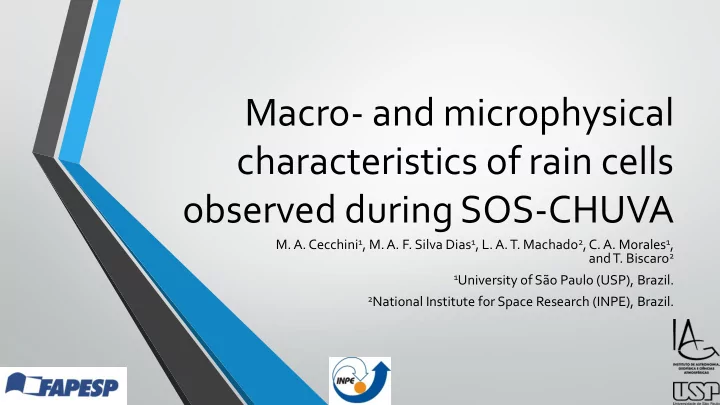

Macro- and microphysical characteristics of rain cells observed during SOS-CHUVA M. A. Cecchini 1 , M. A. F. Silva Dias 1 , L. A. T. Machado 2 , C. A. Morales 1 , andT. Biscaro 2 1 University of São Paulo (USP), Brazil. 2 National Institute for Space Research (INPE), Brazil.
Introduction and Motivation • The number and the impact of severe weather events is increasing due to the increase in population and climate change • Development of objective Nowcasting Tools to support operators
Objective and Methodology • The main goal is to use a weather radar to estimate macro- and microphysical properties of rain cells in Campinas, Brazil • Similar to the phase space introduced in Heiblum et al. (2016) 1 , it is defined the Center of Activity (COA - the rain cell altitude with the highest amount of water mass) combined with the Vertically Integrated Liquid (VIL). • Tracking convective systems using the SOS-CHUVA X-band radar – summer of 2016/2017 1 Heiblum, R. H., et al. (2016), Characterization of cumulus cloud fields using trajectories in the center of gravity versus water mass phase space: 1. Cloud tracking and phase space description, J. Geophys. Res. Atmos., 121, 6336 – 6355, doi:10.1002/2015JD024186.
Methodology • Tracking on 2 km CAPPIs ~34 dBZ (from the near mature to dissipation) • ForTraCC algorithm (Vila et al., 2008) 2 • All clouds treated individually as a cylinder (R + 2 km), following the center of mass. • Z > 30 dBZ in Figures d-f • It allows the examination of the 3D configuration in a Lagrangean way • Total of 446 rain cells • For each moment the COA and VIL were stored together with the 3D fields of the respective polarimetric and microphysical properties 2 Vila, D. A., Machado, L. A. T., Laurent, H. & Velasco, I. (2008). Forecast and Tracking the Evolution of Cloud Clusters (ForTraCC) Using Satellite Infrared Imagery: Methodology and Validation. Weather Forecast , 23(2), 233 – 245. doi:10.1175/2007WAF2006121.1.
Results COA is related to the systems water amount and H top
Results COA captures systems overall appearance
Results Only non-merger/split Decaying COA andVIL for both short- and long-lived cells. Long-lived cells retain more relativeVIL with decaying COA
Results • VIL and COA can be used to constrain microphysical analysis • Figures are for the rain cells core, at the COA level (median properties) • 1 km layer aroundCOA • Z > 30 dBZ; Z dr > 0.5 dB; K dp > 0 ° km -1 ; ρ HV > 0.97 – focus on rain droplets • Elevation angles ≤ 15° • No stratiform events, no merger/splits detected by ForTraCC • 291 rain cells remained • Z, Z dr and K dp grow with VIL and decayingCOA • Overall phase space • Individual rain cells will have different trajectories
Results • The Gamma DSD is estimated from the volumetric fields of Z , Zdr and Kdp following Kalogiros et al. (2013) 3 . • Shift close toVIL = 3 kg m -2 • Reminds a “ maritime-like ” to “continental -like ” transition • Shift is close to the capping in previous slide – still nuclear if physical or methodological 3 Kalogiros, J., Anagnostou, M. N., Anagnostou, E. N., Montopoli, M., Picciotti, E. & Marzano, F. S. (2013). Optimum estimation of rain microphysical parameters from X-band dual-polarization radar observables. IEEE Trans. Geosci. Remote Sens. , 51(5), 3063 – 3076. doi:10.1109/TGRS.2012.2211606.
Results VIL (km m -2 ) Case # COA H top New/Split/Merger/ Total A (km 2 ) and (km) (km) Continuity Accumulated time Rainfall steps (mm) (UTC) Case 1 17:40 4.5 6.49 9.0 New 78 14 17:50 3.5 2.49 8.6 Continuity 267 41 18:00 4.0 2.08 9.0 Continuity 404 36 18:10 3.5 3.41 9.5 Merger 763 133 18:20 3.5 2.60 9.1 Continuity 1014 85 18:30 3.5 1.76 9.1 Split 1131 34 Case 2 18:50 4.5 2.41 6.6 New 73 18 19:00 2.5 2.13 7.0 Continuity 209 22 19:10 2.0 1.04 7.0 Continuity 302 26 19:20 2.0 0.74 7.0 Merger 350 19 19:30 2.0 0.86 7.0 Continuity 413 20 19:40 2.0 0.66 7.1 Continuity 480 27
• Vertical profiles of polarimetric variables • Cell core – Z above 75% percentile below 4.5 Z km, Z dr column criteria from Carlin et al. (2017) 4 between 4.5 km and 8 km • Different vertical profiles for slow- (Case 1) and fast-decaying (Case 2) COA Z dr • High COA related to Z dr column • Favor higher Z and Z dr above 4.5 km • More hydrometeor mixture • Consistent with more intense system – Case 1 produced more than double the overall K dp rainfall of Case 2 ρ HV 4 Carlin, J.T., Gao, J., Snyder, J.C., & Ryzhkov, A.V. (2017). Assimilation of ZDR Columns for Improving the Spinup and Forecast ofConvective Storms in Storm-Scale Models: Proof-of-Concept Experiments. Mon. Wea. Rev., 145, 5033 – 5057. doi:10.1175/MWR-D- 17-0103.1.
• Case 1 profiles also resemble profiles of highly electrically active systems in Brazil (Mattos et al., Z 2016) 5 • In the first time steps – our methodology might capture systems right before the first lightning Z dr K dp ρ HV 5 Mattos, E. V., Machado, L. A. T., Williams, E. R., & Albrecht, R. I. (2016). Polarimetric radar characteristics of storms with and without lightning activity. J. Geophys. Res. Atmos. , 121, 14,201 – 14,220. doi:10.1002/2016JD025142.
Conclusions • Introduced the VIL/COA combination to study rain cells • May tell about the systems life cycle, appearance and microphysical characteristics • Can be useful to roughly estimate microphysical properties from non dual polarization radar • Could be useful for operational purposes – VIL/COA can indicate systems life cycle stage, intensity and electrical activity
Thank you! Acknowledgements: SOS-CHUVA was funded under project grant FAPESP 2015/14497-0. Micael A. Cecchini was supported by FAPESP grant number 2017/04654-6.
Recommend
More recommend